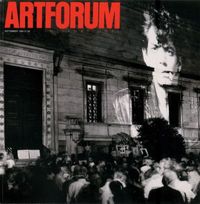 (Click image to enlarge)
(Click image to enlarge)
1. Jen Graves on Christina
Orr-Cahall, soon to be director and CEO of EMP, here. Good piece. What happened two decades ago at the Corcoran still matters. It’s a decision that echoes outward, and 19 years of admirable service at the Norton cannot erase it.
What Graves didn’t do is get inside the decision to cancel the Mapplethorpe show. That’s because Orr-Cahall won’t talk about it. Is there a gag order? What was going on with the Corcoran board? I heard indirectly from a couple of Orr-Cahall’s friends that she was trapped between big-money board members who insisted the show be canceled and the very real fear that the government would cut off all Corcoran funding if the Mapplethorpe show proceeded.
Looks as if she took the bullet for the team. Yes, she did the wrong thing. If she couldn’t proceed, she should have resigned, which is easy to say now.
One thing is clear: EMP blew its introduction. The museum needed to raise the issue and provide a response. Asked and answered. Instead, it counted on lazy or nonexistent press to ignore it.
(Michael Brenson on the 1989 cultural moment here. Richard Lacayo on the economic reality of the fallout here.)
One further thought: Graves compares the odious Helms to Hitler. If Helms had forced unruly artists into labor camps followed by liquidation, it would be a point worth making. Otherwise, it’s an off-putting cliche. The shock value is gone. What’s left is stale overkill. On the other hand, when Tony Curtis compared kissing Marilyn Monroe to kissing Hitler, he scored. The image of kissing refreshed the insult and made it stick.
2. Kenneth Baker on Wayne Thiebaud, here. An insightful Thiebaud review is essential for the Bay Area’s premier newspaper, and Baker came through:
Thiebaud’s early paintings of pastries and other foodstuffs took seriously the roots of still life as subject matter originally meant to domesticate high art for a nascent middle-class audience and market. His pictures did something analogous: They made the esoteric pleasures of brushwork, color and materiality democratically available by pushing parallels between paint and frosting, color and sweetness, intensities of visual and gustatory sensation.
The new paintings use those tactics to disguise a meditation on the surrealism that lurks within all pictorial illusion.
3. David Pagel’s Elias Simé: Eye of the Needle, Eye of the Heart at the Santa Monica Museum of Art, here.
To step into the fantastically jam-packed installation now at the Santa Monica Museum of Art is to step into another world: a nuanced universe suffused with compassion, sensuality and wisdom, a place so far removed from the cold calculations and multi-tasking distractions of life in Los Angeles that it seems you have to be a specialist (or very privileged) to go there.It’s all too easy to see the 60-plus sculptures, 40-odd paintings, seven thrones and five wall reliefs by Ethiopian artist Elias Simé as an anthropologist would: ingenious artifacts from a fully formed culture fundamentally different from our own and probably part of a way of life being squeezed out by global consumerism.
But Elias Simé: Eye of the Needle, Eye of the Heart is nothing of the sort.
4. Edward Winkleman on Julie Evan, here.
The thought that went through my mind as I viewed Julie’s show (in addition to thinking she’s been holding back on the sensuality quotient…these drawings are smokin’ hot) was how sometimes an artist’s accomplishments simply cannot be rushed. It can take just the right combination of life experiences, exposure to other ideas, and simply being in the right place at the right time for things to click. None of which may make sense to even the artist (or be particularly pleasant) at the time, but which definitely results in an eventual accomplishment that enriches our lives.



RE: 1. Christina Orr-Cahall
I can’t believe you’re ready to fight those battles again. The Art managers were wrong then and the situation has not improved under their auspicious stewardship since.
JVK
I think these issues are still worth exploring. Some actions ripple on in time. Regina
Enjoy checking in with you. But I wish that instead of complaining about other journalists failing to cover various stories as fully as you’d like — that you’d just report it fully yourself. Sniping at others for not doing enough, while not bothering to do the reporting yourself, doesn’t really work.
Good point, Clement.
While it’s easy to say what someone should have done 20 years ago, it’s also easy to say what a story should be after it’s published, the writing equivalent of backseat driving.
But unlike the majority of driving situations, criticism is open to response and commentary. Ideally, writing about a finished product helps keep that product in a discussion. Otherwise, as Woody Allen said in another context, writing criticism is “like playing tennis with the ocean”. Regina
What’s your source for the Woody quote?
“Otherwise, as Woody Allen said in another context, writing criticism is ‘like playing tennis with the ocean.'”
Just curious. A search for various iterations of it online turns up nothing.
— An Allen fan
Hi Patrick, otherwise known as Superfurry: Sorry, I don’t have it. It was during an interview when he was talking about doing stand-up comedy for his parents. He said he never tried, even as a child, because it would be “like playing tennis with the ocean.” The phrase stuck to me. Regina